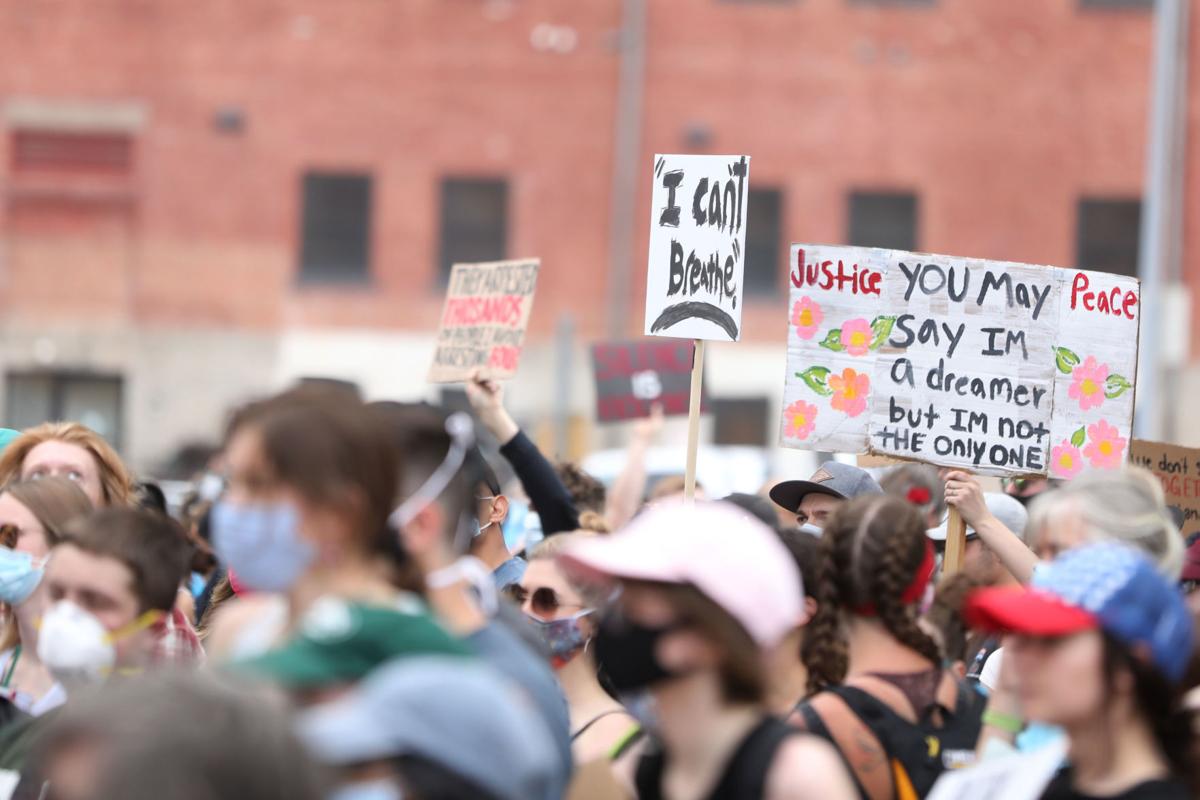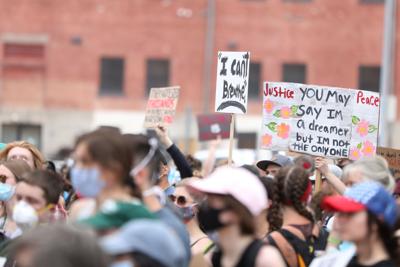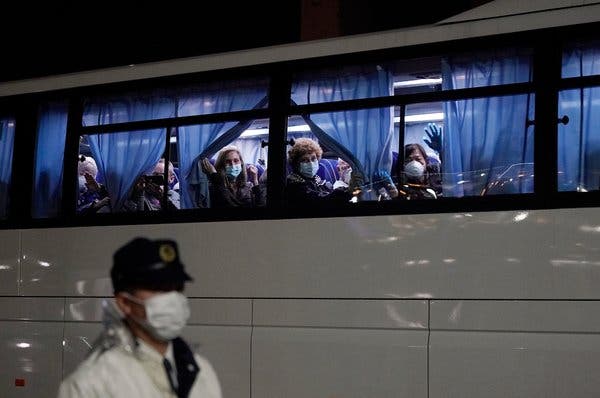307 Politics: The parallels between 1968 and 2020

Several demonstrators hold signs aloft in front of the Hall of Justice on Wednesday in downtown Casper.
Cayla Nimmo, Star-Tribune
Thousands marching, arms raised and chanting for change. Windows smashed. Protesters gassed and beaten by armored police. The White House on lockdown, and the world’s most powerful man watching it all unfold behind a two-mile border of concrete block and steel fence.
The scenes that have unfolded on computer screens and television sets over the past week have been shocking, inspiring, enraging and emotional: an outpouring of communal rage fueled by decades of police misconduct, months of economic strife and, at its core, a breaking point in hundreds of years of systemic oppression against people of color.
“History doesn’t repeat itself, but it often rhymes,” the famed writer Mark Twain was once purported to have said. And while 2020’s movement is a unique episode in American history – pulling together communities of varying sizes, political beliefs and demographics in ways rarely seen before — it does have a close cousin: the summer of 1968.
Overseas, the largest military campaign of the Vietnam War, the Tet Offensive, drew in thousands of young Americans while, on the ground in the United States, the period of the Civil Rights movement was coming to a calamitous end, with the assassination of Martin Luther King Jr. sparking riots and marches in cities across the U.S.
Today’s citizens face similar circumstances, building a coalition united against the system that enabled them. Consecutive economic crises and unending war have shattered faith in American institutions across the board, while persistent racial disparities in American policing and the documented killings of unarmed men and women of color have exacerbated tensions with communities already at a systemic disadvantage. According to an ABC News/Ipsos poll released Friday, three-quarters of Americans view the recent killing of George Floyd at the hands of police as a sign of a “larger problem” in American society, while the protests occurring across the country have garnered the support of 64 percent of Americans.
But 1968 was also an election year, in which the “law and order” candidate, Richard Nixon, found himself embroiled in debate with Democrat Edmund Muskie and Alabama Governor George Wallace, a former Dixiecrat whose racist rhetoric birthed a Southern populism that, paired with rapidly declining faith in government, laid the groundwork for a new conservative coalition of Southerners in the late-60s that became an integral part of the new Republican majority in the late-20th Century.
In the fall, voters across Wyoming will go to the polls once again to pick their president. And once again, Donald Trump – the incumbent – is expected to easily win Wyoming’s delegates, with the state’s Republican supermajority and a high presidential approval rating all but guaranteeing victory.
As the marches continue, the president has similarly worked to position himself as the candidate of “law and order.” His statements about the protests and marches often decry the violence and rarely advocate for reform.
Heading into the 2020 elections, the racial overtones of the past four years – the white supremacist marches of the Unite the Right rallies in Charlottesville, the disparate amount of deaths of people of color in the wake of the COVID-19 pandemic – could play a key role in the decisions of many Americans.
Could those trends potentially move the needle on Trump’s support in Wyoming? If the elections of 1968 are any indication, the prospect is unlikely. As it went for Trump, all but two counties in Wyoming – which was still electing Democratic governors with regularity at the time – went hard for Nixon amid the tumultuous era, delivering his fifth-strongest performance in any state. (The incendiary Wallace, meanwhile, netted nearly 9 percent of the vote in Wyoming, including more than 13 percent in Sublette County.)
Race played a big part in those elections, with each side’s positions on civil rights and racial disparities a defining issue. Today, that divide is likely stronger, says Case Western Reserve University’s Jason Buchler, an expert in political parties and polarization in American politics.
While 1968 was a critical turning point in American politics, Wyoming – political scientists say – was already in the midst of a greater political transformation that had begun four years earlier with the campaign of Republican Barry Goldwater, whose coalition of Western conservatives and disaffected Southern Democrats is largely credited for laying the groundwork for the modern Republican Party that would, eventually, claim majorities in Washington and in statehouses around the country.
“Wyoming and other states were still voting Democrat through the ‘60s and early ‘70s,” Paul Croce, a Stetson University political scientist, said in an interview. “But by the late ‘70s and into the ‘80s, that kind of Western populism – what Goldwater represented – was able to score majorities in the Western states.”
Though Johnson easily won Wyoming in 1964, Goldwater would be the last Republican presidential candidate to lose a race in the Equality State. Meanwhile, neighboring states like Nebraska, Idaho, Utah and North Dakota – all of which backed Johnson in ‘64 – would eventually flip to become Nixon’s strongest states in the ‘68 elections, forming an unlikely alliance between the traditionally moderate electorate of the Rocky Mountain West and the segregationist sensibilities of Southern conservatives.
“Something really important shifts in the thinking of a lot of Republicans in the North, and they follow the Republican Party into this new way of thinking about race,” said Catherine Stock, a Connecticut College professor and Minnesota native working on a book about politics in the Dakotas. “This new way to think about white nationalism, but also all the other factors that eventually becomes the Reagan Revolution: small government, anti-regulation and eventually, anti-immigration.”
That coalition, Buchler said, has only solidified in the ensuing decades with the Reagan revolution, both Bush presidencies and the rise of Trump, galvanizing an environment where Republican and Democratic perspectives on race were already greatly different from one another. While extensive research has shown that civil rights protests led to improved performance for Democratic candidates in the years following the Civil Rights movement, today’s political environment could make it unlikely that issues of race will sway conservatives to the other side, he said.
“The party division right now is, in many ways, a racial division,” Buchler said. “Not just because the Republican Party is very much a white party and the Democratic Party is a more racially diverse party, but because the parties are very split in their views on policies as they as they relate to issues of race and civil rights. So when you have the kinds of protests and you have a president who goes out of his way to polarize on anything, really anything, that’s going to create a different kind of politics than 1968.”
But 1968 could be an imperfect parallel in other ways: across Wyoming this past week, hundreds of marchers in numerous cities marched in solidarity with the Black Lives Matter movement, marking one of the largest single shows of activism in state history. While rallies in Casper and Gillette featured numerous counterprotesters chiding the marchers with Trump flags in tow, the marches themselves were nonpartisan; defined by their focus on the value of black lives and reform rather than political party.
“There is something different [between today and the 1960s],” former President Barack Obama, a Democrat, said in a televised address Wednesday. “You look at [today’s] protests, and that was a far more representative cross-section of America … That didn’t exist back in the 1960s, that kind of broad coalition.”
History can be a reliable predictor of future events in many cases. Whether Wyoming’s solidarity results in tangible change this time around, however, will fall on the shoulders of voters themselves to embody that change.
“Big political realignments tend to come with big upheavals like we’re seeing now,” said Scott Henkel, a professor in the Department of African and Diaspora Studies at the University of Wyoming who has studied 19th and 20th Century political movements. “In the 19th Century, the Republican Party was born from the fight against slavery. The New Deal coalition that came together in the 1930s basically governed the country into the 1950s. Are we on the cusp of a similar, big political realignment?”
The Week AheadMonday:
Select Committees on Federal Natural Resources and Minerals, Broadband to meet remotely.
Tuesday:
Joint Appropriations Committee to meet remotely.
Wednesday:
Joint Committee on Corporations, Elections, and Political Subdivisions to meet remotely.
Thursday:
Corporations Committee to continue meeting.
Friday:
None.
Weekend:
None.
Have an event you’d like highlighted here? Email me with the date, time, and place!Wyoming Politics
After near-miss in Legislature, nonprofits excluded from state’s business relief package: The final rules for the $50 million in funding omitted nonprofit organizations from consideration for the funds, taking lawmakers and some in the nonprofit community by surprise. (via Trib.com
)
Absentee ballot requests in Laramie County already higher than 2016 primary totals: A month out from the start of early and absentee voting for Wyoming’s August primary, the number of requests for absentee ballots in Laramie County this year has already surpassed the total number of ballots distributed in the entire 2016 primary election. (via the Wyoming Tribune-Eagle
)
Gordon says upcoming budget cuts will ‘likely lead to some employees losing their jobs’: Upcoming cuts to state spending will “likely lead to some employees losing their jobs” as Wyoming continues to grapple with the economic fallout of COVID-19, collapsed oil prices and continuing declines in natural gas and coal, Gov. Mark Gordon said Thursday. (via Trib.com)Around Wyoming
“Isolated situation or part of a culture?”: Release of redacted McCormick investigation delayed: Inquisitive minds will have to keep waiting to read a currently sealed report of an investigation into racist and homophobic student activity at Cheyenne’s McCormick Junior High School that commenced more than one year ago. (via The Wyoming Tribune-Eagle
)
Meanwhile, groups like Cheyenne Juntos – an advocacy group representing the city’s immigrant community – have launched a petition pushing
for greater representation on the school board there.
Gillette residents gather for Trump and ‘All Lives Matter’: Amid vigils and demonstrations against police brutality across Wyoming and the nation, a group of people supporting President Donald Trump and “All Lives Matter” peacefully waved their flags at motorists on the corner of Highway 59 and East Boxelder Road outside Gillette last week. (via The Gillette News-Record
)
Despite monthlong effort, private endeavor to raise sage grouse in captivity hits a snag: A great read by photojournalist Mark Davis on the challenges of the controversial effort to save the imperiled species. (via The Powell Tribune
)
More tax relief for oil and gas could be on the horizon in Wyoming: The Legislature’s Joint Minerals, Business and Economic Development committee moved to draft a new bill that would reduce the severance tax for oil and gas producers by 50 percent for a consecutive six-month period when oil prices hit $45 a barrel. (via Trib.com)Eye On Washington
John Barrasso
co-sponsored legislation with his Senate colleagues to clarify and expand sanctions on Russia regarding the expansion of its NORD STREAM 2 pipeline into Western Europe, a move the U.S. fears could leave allies there susceptible to Russian influence.
He also went on Fox News
to promote wide-ranging infrastructure legislation – a talking point of his for years – and took to the Senate floor to decry the killing of George Floyd at the hands of police, whose death later sparked rallies that took hold around the nation.
Mike Enzi,
the Senate’s most well-established deficit hawk, warned colleagues last week that the U.S. may not have the tools it needs to address its next fiscal crisis.
Liz Cheney
praised efforts within the Environmental Protection Agency to roll back a number of environmental regulations under the Clean Air and Clean Water Acts she said have restricted growth for Wyoming businesses.
“I commend the EPA for revising the Obama era policies that were weaponized by far-left bureaucrats with little to no input from Wyoming’s ranchers and energy producers,” she wrote in her weekly newsletter on Friday.
Have any tips or suggestions to make this newsletter better? Let me know! Call me at 307-266-0634, email me at nick.reynolds@trib.com or follow me on Twitter, @IAmNickReynolds










